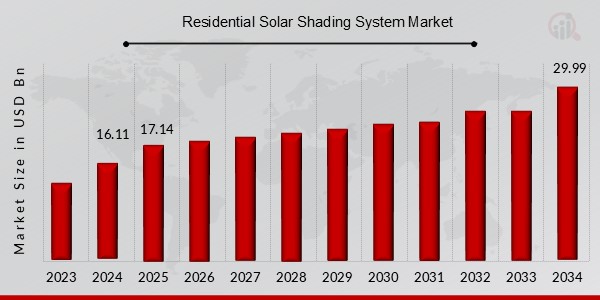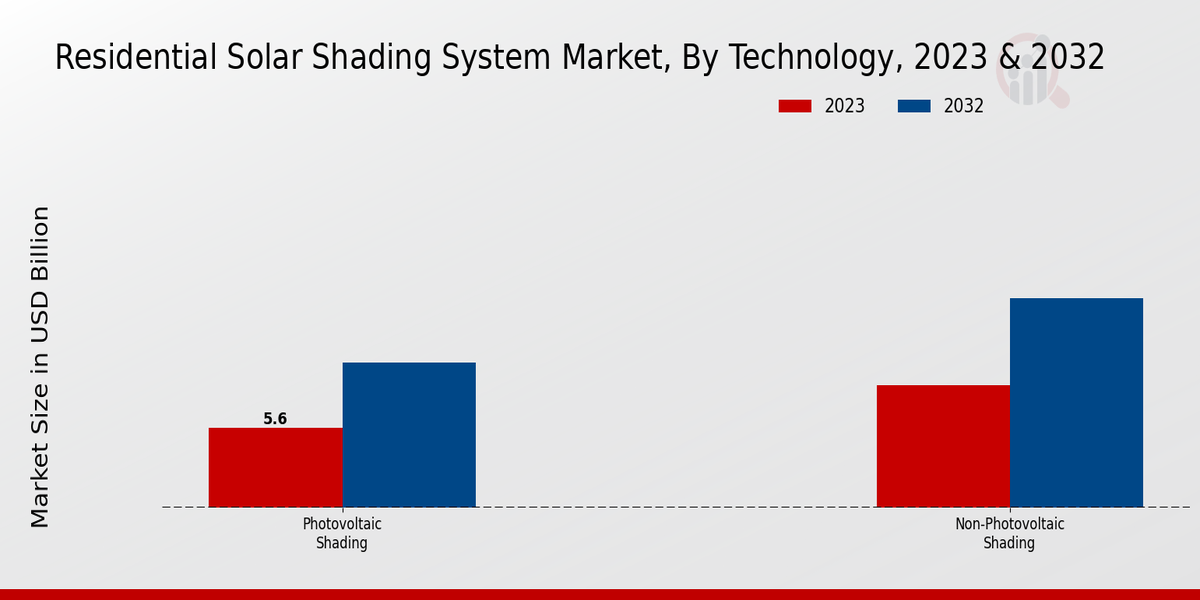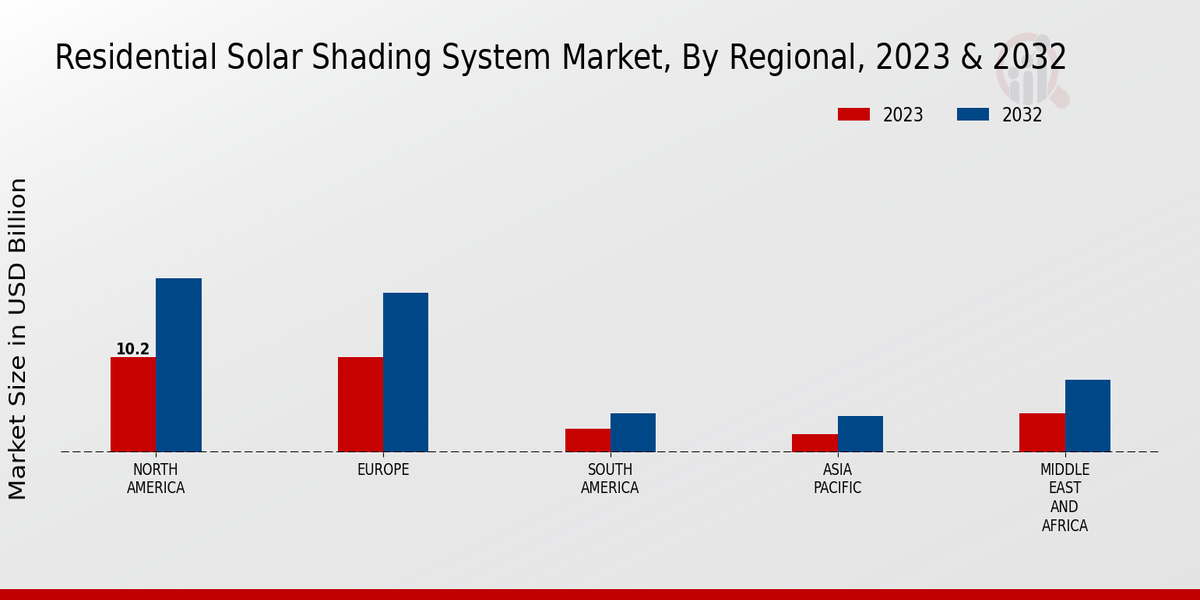Global Residential Solar Shading System Market Overview
The Residential Solar Shading System Market Size was estimated at 16.11 (USD Billion) in 2024. The Residential Solar Shading System Industry is expected to grow from 17.14 (USD Billion) in 2025 to 29.99 (USD Billion) by 2034. The Residential Solar Shading System Market CAGR (growth rate) is expected to be around 6.4% during the forecast period (2025 - 2034).
Key Residential Solar Shading System Market Trends Highlighted
The market of Residential Solar Shading System Market is experiencing a surge in demand, driven by rising energy costs, environmental concerns, and the need for comfortable indoor living spaces. The growing adoption of smart home technologies and increasing awareness about the benefits of solar shading solutions are further fueling market expansion. Homeowners are increasingly opting for automated and energy-efficient shading systems that provide optimal light and temperature control, reduce glare, and enhance privacy. Additionally, government incentives and regulations aimed at promoting energy efficiency are creating favorable growth prospects for the industry.

Source: Primary Research, Secondary Research, Market Research Future Database and Analyst Review
Residential Solar Shading System Market Drivers
Rising Energy Consumption and Environmental Concerns
The growing demand for energy, coupled with increasing environmental awareness, is driving the adoption of sustainable energy solutions. Residential solar shading systems offer a cost-effective and environmentally friendly way to reduce energy consumption and carbon footprint. By regulating the amount of sunlight entering a building, these systems can minimize the need for air conditioning, leading to significant energy savings.
Additionally, the use of solar shading systems can reduce greenhouse gas emissions, contributing to climate change mitigation efforts.The growing focus on energy efficiency and sustainability is expected to continue to drive the demand for residential solar shading systems in the coming years.
Government Incentives and Regulations
Governments worldwide are implementing various incentives and regulations to promote the adoption of renewable energy technologies. These incentives can include tax credits, rebates, and net metering programs that encourage homeowners to install solar shading systems. Furthermore, building codes and energy efficiency standards are becoming more stringent, requiring the use of energy-efficient building materials and systems. These government initiatives are expected to stimulate the demand for residential solar shading systems as homeowners seek to comply with regulations and take advantage of financial incentives.
Technological Advancements and Cost Reductions
Technological advancements in solar shading systems are leading to improved efficiency and reduced costs. The development of new materials and innovative designs is enhancing the performance and durability of these systems. Additionally, economies of scale and manufacturing efficiencies are driving down the cost of solar shading systems, making them more accessible to homeowners. As technology continues to evolve, the Residential Solar Shading System Market Industry is expected to benefit from increased adoption and cost-effectiveness.
Residential Solar Shading System Market Segment Insights:
Residential Solar Shading System Market Technology Insights
The Residential Solar Shading System Market is segmented by technology into Photovoltaic (PV) Shading and Non-Photovoltaic (NPV) Shading. Photovoltaic (PV) Shading: PV shading systems generate electricity from sunlight and can be used to power homes or businesses. They are becoming increasingly popular as the cost of solar panels decreases. The Residential Solar Shading System Market for PV shading is expected to grow from USD 5.6 billion in 2023 to USD 10.2 billion by 2032, at a CAGR of 7.2%.
Non-Photovoltaic (NPV) Shading: NPV shading systems do not generate electricity from sunlight.Instead, they rely on passive design features to reduce heat gain and glare. NPV shading systems are typically less expensive than PV shading systems, but they are also less efficient. The Residential Solar Shading System Market for NPV shading is expected to grow from USD 8.6 billion in 2023 to USD 14.7 billion by 2032, at a CAGR of 6.7%.
The market growth of both PV and NPV shading systems is being driven by a number of factors, including rising energy costs, increasing awareness of the benefits of solar energy, and government incentives for renewable energy installations.

Source: Primary Research, Secondary Research, Market Research Future Database and Analyst Review
Residential Solar Shading System Market Application Insights
The Residential Solar Shading System Market is segmented based on Application into Windows, Skylights, Doors, and Patios and Pergolas. Among these, the Windows segment held the largest market share in 2023, accounting for over 40% of the market revenue. This dominance is attributed to the increasing adoption of energy-efficient solutions in residential buildings, coupled with government regulations promoting sustainable construction practices.
The Skylights segment is projected to exhibit the highest CAGR during the forecast period, owing to the growing demand for natural lighting and improved indoor air quality.Additionally, the Patios and Pergolas segment is expected to witness significant growth due to the rising popularity of outdoor living spaces and the need for protection from the sun's harmful rays.
Residential Solar Shading System Market Product Type Insights
The Residential Solar Shading System Market is segmented by product type into exterior shading, interior shading, and integrated shading. Exterior shading systems are installed on the outside of a building and include products such as awnings, louvers, and shutters. Interior shading systems are installed on the inside of a building and include products such as blinds, shades, and curtains. Integrated shading systems are a combination of exterior and interior shading systems and offer the benefits of both types of systems.
The exterior shading segment is expected to account for the largest share of the Residential Solar Shading System Market in 2024, with a market value of USD 12.2 billion.The growth of this segment is attributed to the increasing demand for exterior shading systems to reduce heat gain and glare in buildings. The interior shading segment is expected to account for the second-largest share of the market in 2024, with a market value of USD 10.8 billion. The growth of this segment is attributed to the increasing demand for interior shading systems to improve privacy and comfort in buildings.
The integrated shading segment is expected to account for the smallest share of the market in 2024, with a market value of USD 8.5 billion.The growth of this segment is attributed to the increasing demand for integrated shading systems to provide a complete shading solution for buildings.
Residential Solar Shading System Market Material Insights
The Residential Solar Shading System Market segmentation based on Material includes Fabric, Metal, Wood, and Glass. Fabric holds the largest market share due to its versatility, cost-effectiveness, and wide range of colors and patterns. Metal is another popular material, offering durability and a modern aesthetic. Wood provides a natural and sustainable option, while Glass offers transparency and allows for natural light to enter the space.
The market for Residential Solar Shading Systems is expected to grow significantly in the coming years, driven by increasing demand for energy efficiency and comfort in homes.The growing adoption of smart home technologies is also expected to contribute to market growth, as solar shading systems can be integrated with home automation systems for remote control and optimization. By 2024, the Residential Solar Shading System Market is projected to reach a value of USD 16.78 Billion, exhibiting a CAGR of 6.8% during the forecast period.
Residential Solar Shading System Market Regional Insights
Regionally, North America held the largest market share in 2023 and is projected to maintain its dominance throughout the forecast period. The growing adoption of solar shading systems in the United States and Canada due to increasing energy efficiency regulations and incentives is driving the market growth in this region. Europe is another key market for residential solar shading systems, with Germany, France, and the United Kingdom being the major contributors.
The rising awareness about energy conservation and the availability of government subsidies are fueling the market growth in this region.The APAC region is expected to witness significant growth in the coming years, owing to the increasing construction activities in emerging economies such as China and India. The rising disposable income and the growing demand for sustainable building solutions are contributing to the market growth in this region. South America and MEA are relatively smaller markets for residential solar shading systems, but they are expected to grow at a steady pace during the forecast period.

Source: Primary Research, Secondary Research, Market Research Future Database and Analyst Review
Residential Solar Shading System Market Key Players And Competitive Insights:
Major players in the Residential Solar Shading System Market industry are focusing on expanding their product portfolio and geographical presence to cater to the growing demand for residential solar shading systems. Leading Residential Solar Shading System Market players are investing heavily in research and development to develop innovative and energy-efficient solutions. The Residential Solar Shading System Market development is being driven by the increasing awareness of the benefits of solar shading systems, such as reduced energy consumption, improved indoor comfort, and enhanced aesthetic appeal.Lutron Electronics is a leading player in the Residential Solar Shading System Market.
The company offers a wide range of solar shading solutions, including motorized shades, blinds, and awnings. Lutron Electronics has a strong presence in North America and Europe and is expanding its presence in Asia Pacific. The company's focus on innovation and customer satisfaction has helped it maintain its leading position in the market.Hunter Douglas is a major competitor in the Residential Solar Shading System Market. The company offers a wide range of solar shading solutions, including blinds, shades, and shutters. Hunter Douglas has a strong presence in North America and Europe and is expanding its presence in Asia Pacific.
The company's focus on sustainability and energy efficiency has helped it gain a competitive advantage in the market.
Key Companies in the Residential Solar Shading System Market Include:
Residential Solar Shading System Market Industry Developments
Rising energy costs and growing awareness of energy efficiency are driving the market growth. Government incentives and regulations promoting the adoption of solar shading systems are further contributing to market expansion. Technological advancements, such as the development of smart and automated shading systems, are also expected to boost market growth in the coming years. Recent news developments include the launch of new products by major players such as Lutron Electronics and Somfy, as well as strategic partnerships and acquisitions to strengthen market presence.
The Asia-Pacific region is expected to witness significant growth due to increasing construction activities and government initiatives promoting green building practices.
Residential Solar Shading System Market Segmentation Insights
Residential Solar Shading System Market Technology Outlook
Residential Solar Shading System Market Application Outlook
Residential Solar Shading System Market Product Type Outlook
Residential Solar Shading System Market Material Outlook
Residential Solar Shading System Market Regional Outlook
| Report Attribute/Metric |
Details |
| Market Size 2024 |
16.11 (USD Billion) |
| Market Size 2025 |
17.14 (USD Billion) |
| Market Size 2034 |
29.99 (USD Billion) |
| Compound Annual Growth Rate (CAGR) |
6.4% (2025 - 2034) |
| Report Coverage |
Revenue Forecast, Competitive Landscape, Growth Factors, and Trends |
| Base Year |
2024 |
| Market Forecast Period |
2025 - 2034 |
| Historical Data |
2020 - 2024 |
| Market Forecast Units |
USD Billion |
| Key Companies Profiled |
Pella Corporation, Andersen Corporation, Kolbe Kolbe Millwork Co, Fakro, Lutron Electronics, Reynaers Aluminium, Deceuninck, Velux, Somfy, Marvin Windows and Doors, Graham Architectural Products, Hunter Douglas |
| Segments Covered |
Technology, Application, Product Type, Material, Regional |
| Key Market Opportunities |
Energy efficiency aesthetic appeal government incentives technological advancements rising demand for sustainable solutions |
| Key Market Dynamics |
Growing environmental awareness Increasing disposable incomes Government incentives Technological advancements Rising energy costs. |
| Countries Covered |
North America, Europe, APAC, South America, MEA |
Frequently Asked Questions (FAQ):
The Residential Solar Shading System Market is currently valued at 17.14 USD Billion.
The Residential Solar Shading System Market is projected to reach a valuation of 29.99 USD Billion by the year 2034.
The Residential Solar Shading System Market is projected to grow at a CAGR of 6.4% from 2025 to 2034.
Key regions driving growth in the Residential Solar Shading System Market include North America, Europe, Asia-Pacific, and the Middle East and Africa.
Key market segments in the Residential Solar Shading System Market include manual solar shading systems, automated solar shading systems, and integrated solar shading systems.
Major applications of Residential Solar Shading Systems include temperature control, glare reduction, and privacy enhancement.
Key factors driving the growth of the Residential Solar Shading System Market include increasing energy efficiency awareness, rising disposable income, and government incentives.
Key challenges facing the Residential Solar Shading System Market include high initial investment costs and a lack of skilled labor.
Key competitors in the Residential Solar Shading System Market include Hunter Douglas, Lutron Electronics, Somfy, and WAREMA.
Expected trends in the Global Residential Solar Shading System Market include increasing adoption of smart home technologies and growing demand for sustainable building materials.
















